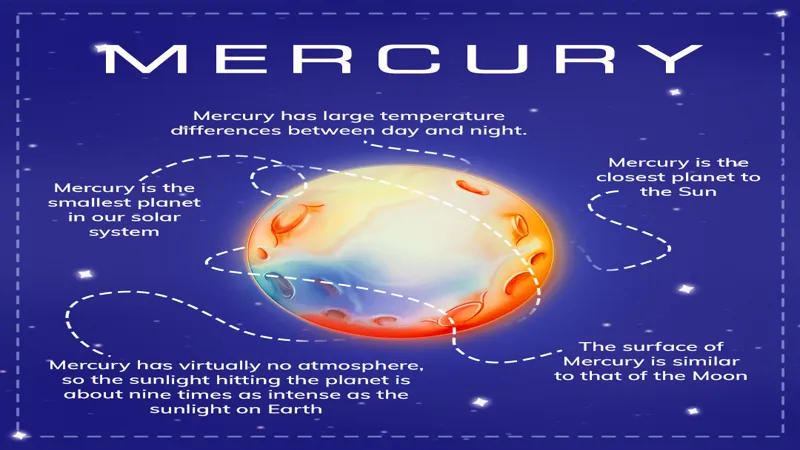Mercury, the enigmatic smallest planet in our solar system, captivates astronomers and space enthusiasts alike with its intriguing characteristics and extreme conditions. Named after the Roman god of commerce, this planet not only orbits closest to the Sun but also races through space at remarkable speeds, completing a full revolution in just 88 Earth days. However, beneath its scorching facade lies a world of contradictions, where ice can exist in shadowed craters, and temperatures swing dramatically from blistering heat to frigid cold. Join us as we delve into the fascinating features of Mercury, uncovering its mysteries and the unique attributes that set it apart from other celestial bodies.
| Attribute | Details |
|---|---|
| Name | Mercury |
| Order from the Sun | 1st (closest) |
| Size | Smallest planet in the solar system (1,516 miles radius) |
| Surface Temperature | 800°F (427°C) during the day; -290°F (-179°C) at night |
| Atmosphere | No significant atmosphere; has a thin exosphere |
| Water Ice | Found at the north and south poles, in permanently shadowed areas |
| Surface Features | Heavily cratered landscape with significant craters like Caloris Basin and Rachmaninoff |
| Core Composition | Large metallic core, about 85% of the planet’s radius |
| Magnetic Field | Unusually strong, creates a magnetosphere despite being 1.1% as strong as Earth’s |
| Orbit and Rotation | One day lasts 176 Earth days; one year lasts 88 Earth days |
| Missions | Three missions: Mariner 10, MESSENGER, and upcoming BepiColombo |
Exploring Mercury’s Ice-Capped Poles
Despite being the closest planet to the Sun, Mercury surprisingly has water ice at its poles. These areas are always in shadow, creating a frigid environment where ice can remain. The MESSENGER spacecraft, which explored Mercury from 2008 to 2015, was the first to find evidence of this ice. Scientists were amazed to discover that even in the heat of Mercury, these hidden pockets of ice exist, showing that not everything is as it seems on this blazing planet.
The presence of ice at Mercury’s poles raises fascinating questions about how water can survive in such extreme conditions. Unlike Earth, where water is abundant, Mercury’s ice is trapped in dark craters where sunlight never reaches. This discovery helps scientists learn more about the planet and its history. Understanding how ice can exist on a planet so close to the Sun also gives clues about other celestial bodies that might have similar hidden resources.
Frequently Asked Questions
What is Mercury known for?
Mercury is the smallest planet in our solar system and the closest to the Sun, known for its fast orbit and extreme temperature variations.
Does Mercury have water?
Yes! Mercury has ice at its poles, even though it’s close to the Sun. This ice is found in permanently shadowed regions.
What are Mercury’s surface temperatures like?
Mercury’s temperatures can reach up to 800°F during the day and drop to -290°F at night due to its lack of atmosphere.
Why doesn’t Mercury have a proper atmosphere?
Mercury lacks a substantial atmosphere because of its weak gravity and close proximity to the Sun, leading to a thin exosphere instead.
How does Mercury’s surface compare to the Moon’s?
Mercury’s surface is very similar to Earth’s Moon, with many craters and little atmosphere, but it experiences more solar radiation.
What is unique about Mercury’s core?
Mercury has a large metallic core that makes up about 85% of its radius, much larger compared to Earth’s core.
How long is a day on Mercury?
A day on Mercury lasts about 58.6 Earth days, while a year (one complete orbit around the Sun) takes just 88 Earth days.
Summary
Mercury is the smallest planet in our solar system and the closest to the Sun. It orbits quickly, traveling at nearly 106,000 miles per hour. Despite its heat, Mercury’s poles have water ice due to permanent shadows. The planet experiences extreme temperatures, soaring to 800°F during the day and dropping to -290°F at night. With no significant atmosphere, it has a thin exosphere made of gases. Its surface is heavily cratered, resembling the Moon, and it has a large metallic core that creates a strong magnetic field. Interestingly, a day on Mercury lasts longer than its year!
